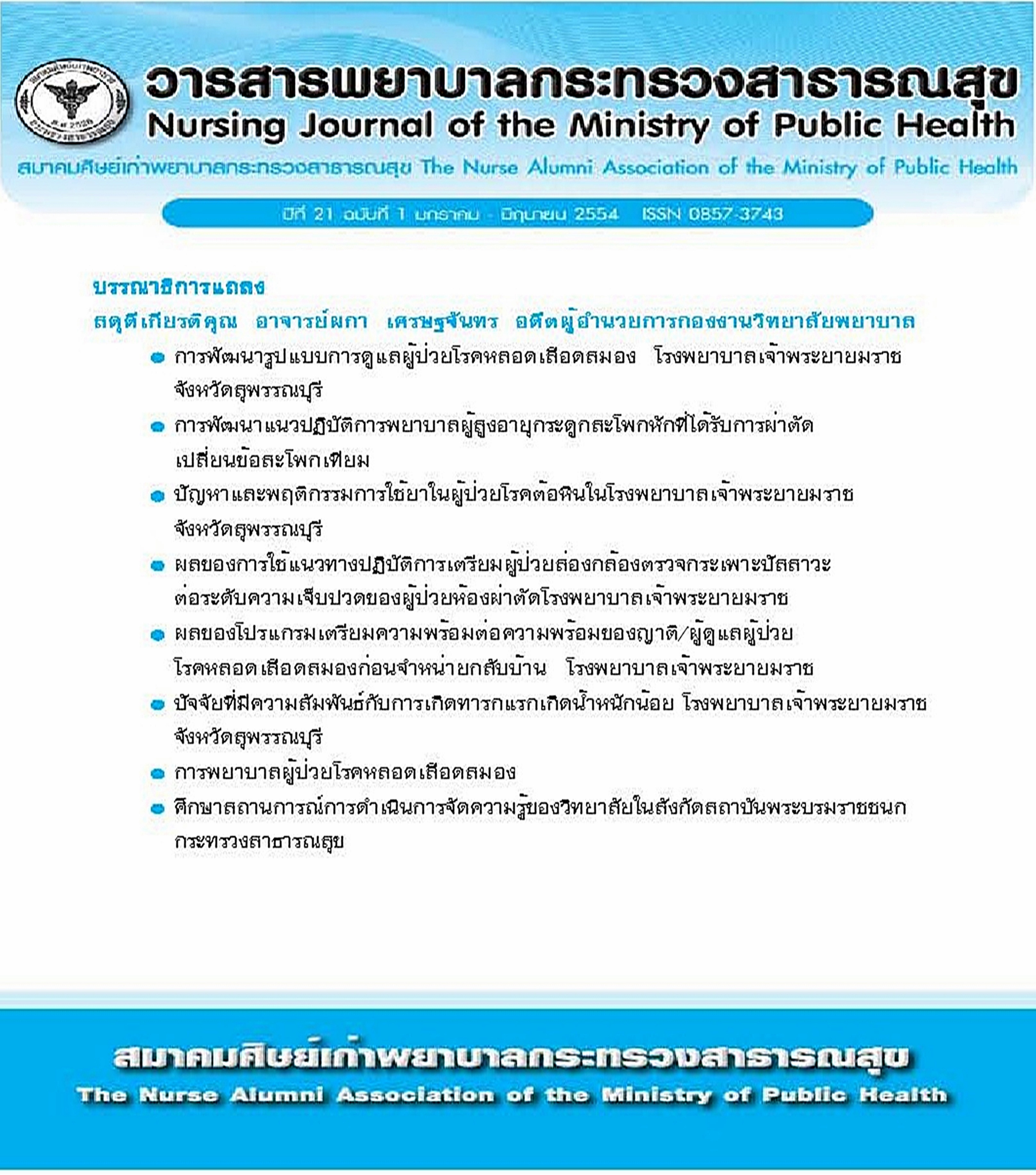การพัฒนารูปแบบการดูแลผู้ป่วยโรคหลอดเลือดสมอง โรงพยาบาลเจ้าพระยายมราช จังหวัดสุพรรณบุรี
Main Article Content
Abstract
บทคัดย่อ
การวิจัยครั้งนี้เป็นการวิจัยเชิงพรรณนา (Descriptive Research) มีวัตถุประสงค์เพื่อพัฒนารูปแบบการดูแลผู้ป่วยโรคหลอดเลือดสมอง โรงพยาบาลเจ้าพระยายมราช สุพรรณบุรี เริ่มดำเนินการช่วงเดือน กุมภาพันธ์ 2552 ถึงเดือนพฤศจิกายน 2552 กลุ่มตัวอย่างเลือกแบบเฉพาะเจาะจง (Purposive Sampling) จำนวน 3 กลุ่ม ได้แก่ 1. กลุ่มผู้ป่วยโรคหลอดเลือดสมอง จำนวน 80 ราย 2 . กลุ่มผู้ดูแลผู้ป่วยที่ทำหน้าที่เป็นผู้ดูแลหลักของผู้ป่วย จำนวน 80 ราย 3. บุคลากร ทีมสหสาขาวิชาชีพ 8 สาขา จำนวน 11 ราย เครื่องมือที่ใช้ใน การศึกษาประกอบด้วย 1. แบบทดสอบความรู้ เรื่องโรคหลอดเลือดสมองของผู้ดูแล ผู้ป่วย 2. แบบประเมิน ดัชนี บาร์เธล เอ ดี แอล ของสถาบันประสาทวิทยา 3. แบบสอบถามความพึงพอใจของผู้ดูแลผู้ป่วยโรคหลอดเลือดสมอง วิเคราะห์หาความเชื่อมั่นโดยหาค่าสัมประสิทธ์ิแอลฟา ของครอนบาค ได้ค่าความเชื่อมั่นเท่ากับ .81, .83 และ .87 ตามลำดับ 4. แบบตรวจสอบการปฏิบัติตามแผนการดูแลผู้ป่วยโรคหลอดเลือดสมองของแต่ละสาขาวิชาชีพ 5. แบบ สัมภาษณ์ทีมสหสาขาวิชาชีพและผู้ดูแลขั้นตอนการดำเนินการวิจัย ประกอบด้วย 3 ขั้นตอน ได้แก่ 1. พัฒนารูปแบบการดูแลผู้ป่วยโรคหลอดเลือดสมอง 2. นำรูปแบบการดูแลผู้ป่วยโรคหลอดเลือดสมองที่พัฒนาไปใช้ 3. ประเมินผลลัพธ์
การพัฒนารูปแบบการดูแลผู้ป่วยโรคหลอดเลือดสมอง การวิเคราะห์ข้อมูลโดยการแจกแจงความถี่ หาค่าร้อยละ ค่าเฉลี่ยเปรียบเทียบความแตกต่างของค่าเฉลี่ย ด้วยสถิติทดสอบ ที (Paired t-test) ข้อมูลเชิงคุณภาพใช้การวิเคราะห์เนื้อหา (Content analysis)
ผลการวิจัยพบว่าผู้ป่วยกลุ่มตัวอย่างมีค่าเฉลี่ยคะแนนความสามารถในการทำกิจวัตรประจำวันด้วยตนเองได้ เป็นส่วนใหญ่ภายหลังการจำหน่าย 30 วัน (X=75.08 , SD= 23.890) ค่าเฉลี่ยคะแนนความสามารถในการทำกิจวัตร ประจำวันภายหลังการจำหน่าย 30 วัน มากกว่าก่อนจำหน่ายอย่างมีนัยสำคัญทางสถิติ (p = .000) ผู้ป่วยโรคหลอดเลือดสมองตีบตันและแตก มีจำนวนวันนอนเฉลี่ยเท่ากับ 4.26 วันและ 7.27 วันและค่าใช้จ่ายเท่ากับ 9,210.73 บาท และ 10,640.57 บาท ตามลำดับ ผู้ดูแลผู้ป่วยมีค่าคะแนน เฉลี่ยความรู้เรื่องโรคหลอดเลือดสมองก่อนจำหน่ายในระดับมากที่สุด (X = 9.15,SD=0.936) และมีค่าคะแนนเฉลี่ยความรู้เรื่องโรคหลอดเลือดสมองก่อนจำหน่ายมากกว่าแรกรับอย่างมีนัยสำคัญทางสถิติ (p = .000) และผู้ดูแลผู้ป่วยมีความพึงพอใจมากที่สุดต่อการบริการของทีมสหสาขาวิชาชีพ (X= 34.23 , SD =2.061) นอกจากนี้ บุคลากรทุกคนในทีมสหสาขาวิชาชีพสามารถปฏิบัติตามแผนได้ครบถ้วนและมีความพึงพอใจเป็นอย่างมาก
ข้อเสนอแนะในการทำวิจัยครั้งนี้ ควรมีการนำรูปแบบการดูแลผู้ป่วยโรคหลอดเลือดสมองขยายสู่หอ ผู้ป่วยอื่น ๆ และโรงพยาบาลเครือข่ายในจังหวัดสุพรรณบุรี นอกจากนี้ควรสร้างรูปแบบการดูแลผู้ป่วยในกลุ่มอื่นๆ และพัฒนาบทบาท ของพยาบาลผู้จัดการในโรงพยาบาลเจ้าพระยายมราช สุพรรณบุรี
คำสำคัญ : รูปแบบการดูแล / ผู้ป่วยโรคหลอดเลือดสมอง
* พยาบาลวิชาชีพชำนาญการพิเศษ หัวหน้ากลุ่มงานการพยาบาล
** พยาบาลวิชาชีพชำนาญการ กลุ่มการพยาบาล
Development of care model for stroke in Choapraya Yommaraj at Supanburi.
Abstract
This descriptive research study aimed to develop care model for stroke patients at Chaophraya Yommaraj Hospital, Suphanburi. The studied was conducted from February, 2010 to November, 2010. Three purposive sampling groups included 80 stroke patients, 80 primary care givers and 8 multidisciplinary
team members from 8 divisions. Applied tools included 1. Stroke knowledge test replied by caregivers, 2. Barthel ADL Index test from the Neurological Institute, 3. Satisfaction questionnaire replied by stroke patients caregivers. Reliability was analyzed by using Cronbach Alpha Co-efficient and showed .80, .83 and .87 reliability respectively, 4. Care procedure checklist replied by stroke multidisciplinary team members from 8 divisions, and 5. Interview replied by multidisciplinary team and caregivers. The process to the development included three steps, namely. 1. To develop care model . 2. To experimental the develop care model . 3. To evaluate development results of the develop care model and data analysis using frequency, percentage, mean average, paired T-test with quantitative data and content analysis.
We had found that most of the patients had gained average point in ability to do activity daily living 30 days after discharge (X = 75.08, SD = 23.890) and stroke patients had gained average point in ability to do activity daily living 30 days after discharge which was higher than before discharge statistically
significant (p = .000). The average length of stay of stroke patients was 4.26 to 7.27 days peradmission, the average medical care cost was 9,210.73 and 10,640.57 baht respectively. The stroke patient caregivers had the highest average point about stroke before discharge (X = 9.15, SD = 0.936) and they had gained more average knowledge about the disease before discharge statistically significant (p = .000). The stroke patients caregivers were also satisfied with multidisciplinary team’s services (X = 34.23, SD = 2.061). Furthermore, all disciplinary team members could follow the procedure completely and were
highly satisfied.
Suggestions from the study were to apply the medical care model for stroke patients at other departments and hospitals in Suphanburi province. In addition, medical care model for other groups of patients need to be developed and to develop or improve the role of practical nurses case manager in Chaophraya Yommaraj Hospital, Suphanburi
Key word : Care model / stroke patients
* Director of Nursing Choapraya Yommarraj Hospital
** Registered Nurse Choapraya Yommarraj Hospital
Kraunvan Piumboriboon
Charoonlux Pongcharoen
Article Details
บทความและรายงานวิจัยในวารสารพยาบาลกระทรวงสาธารณสุข เป็นความคิดเห็นของ ผู้เขียน มิใช่ของคณะผู้จัดทำ และมิใช่ความรับผิดชอบของสมาคมศิษย์เก่าพยาบาลกระทรวงสาธารณสุข ซึ่งสามารถนำไปอ้างอิงได้
